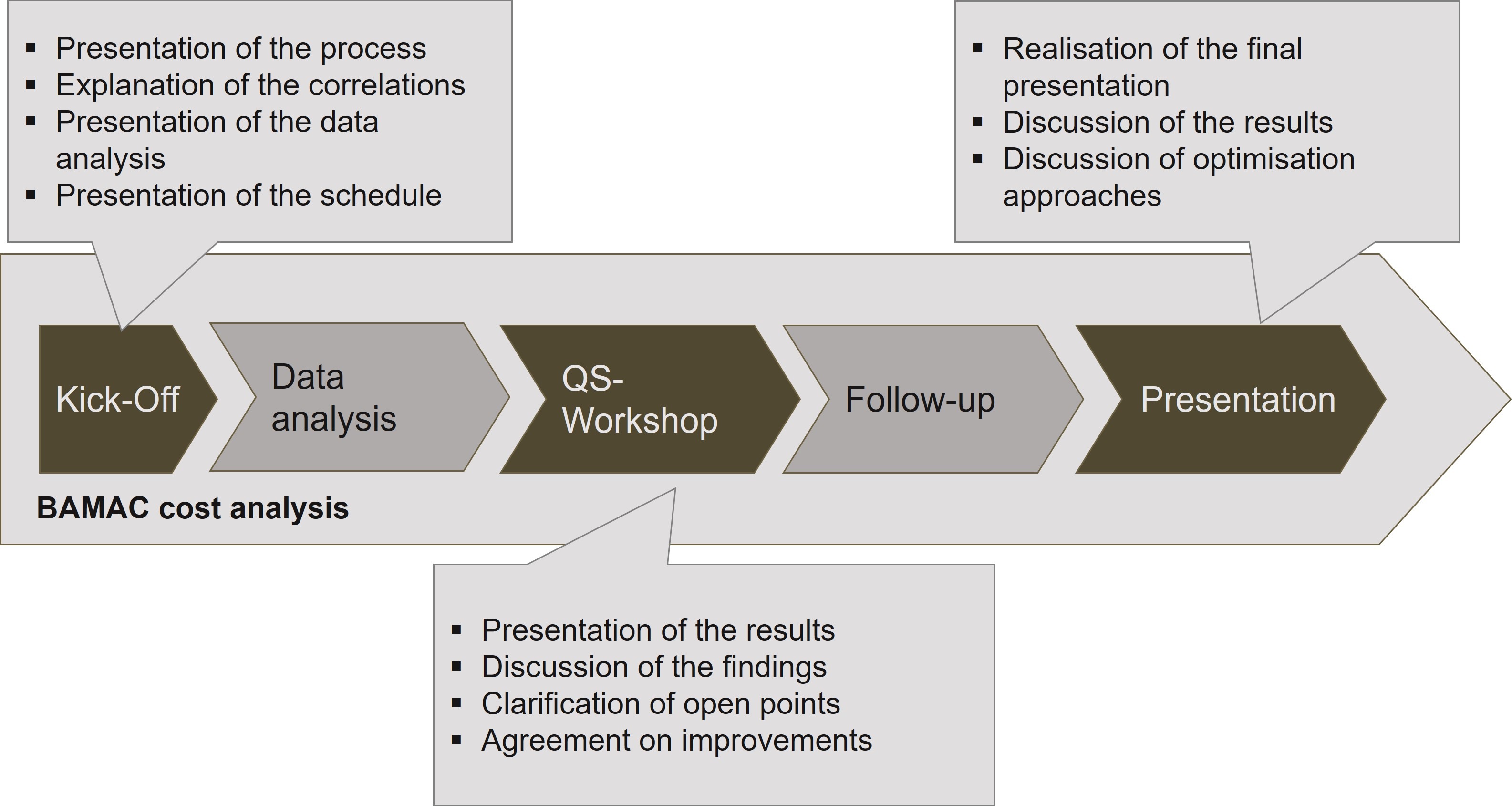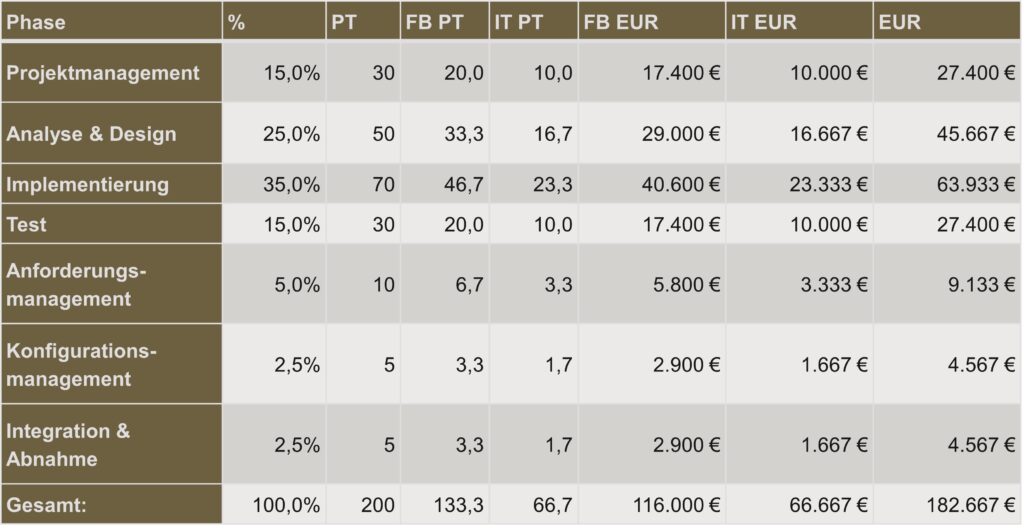Case Study: Increase the predictability of IT development projects!
Are you looking for more planning security in the development of IT projects? Here we show you how the plannability of IT development projects can be significantly increased in just five steps.
Increase planning security for IT development projects
Is the development of IT projects always more complex than initially promised? Everything takes longer and costs more? And planning security seems to be a foreign concept? Today we’ll show you that this doesn’t have to be the case.
The predictability of IT development projects can be significantly increased in just five steps. The BAMAC GROUP uses a tried and tested data analysis procedure to estimate expenses.
Initial situation
IT project portfolio management involves the planning and management of all IT projects within an organization. The basis of an IT project are the requirements that are to be implemented in the form of functions in the IT products. To do this, it is necessary to determine which requirements are to be met and how much effort and functionality the new IT products will require. We would like to emphasize one thing at this point:
The effort and functional scope of IT projects are not linear and are therefore not intuitive!
These exponential growth curves are caused by a number of external circumstances. The inherent agility of IT projects has a direct impact on planning capability. The degree to which information is passed on and the quality of information within the various teams, specialist departments, etc. also has an influence on the progress of the IT project. The same applies to the targets. Whether and how clearly these are formulated, whether they are fixed or rather roughly outlined, influences the process and the planning reliability of an IT project.
For this reason, a high estimation quality contributes to an improved predictability of IT development projects.
We will show you how this can be achieved.
How do you estimate?
In the following, we will show you how to obtain an estimate. First, data on your own productivity is stored in the baseline. The productivity data was determined by recalculating completed projects. This process increases the estimation quality.
In this case study, a rough concept with the functional and technical requirements was available. For this reason, an estimate was initially carried out as part of the quotation process. This was then incorporated into the IT project portfolio planning. The aim was to achieve a high estimation quality and to point out any risks at the estimation stage.
An estimate must be accurate and repeatable.
There are two important criteria to consider when making an estimate. It must be accurate and repeatable, as this ensures that IT development projects can be better planned.
In order to ensure the aspect of repeatability, we proceed in two steps when calculating expenses. First, we use function point analysis to determine the scope of functions according to the functions to be implemented. We measure this scope in Function Points (FPs). Based on the FPs, we use the above-mentioned company-specific baseline to determine the required effort in person days (PT). If such a database is not available, we use data from the BAMAC GROUP. From experience, we can say that if a company-specific baseline is used for the estimate, the quality of the expense is less than 5%.
When is the estimate made?
An estimate is always made when the scope of functions changes. Changes in the scope of functions can occur consciously during the course of the project due to further detailing or extensions to functions, or unconsciously. This process of unconscious expansion is also known as scope creep. A score creep is caused, for example, by detailing functions that are already known. Estimates are therefore made more frequently during the implementation of the IT project.
Typical times are
- Preliminary project
- Project order
- Analysis & Design
- Implementation
- Test
In other words:
the effort required to implement the project is the subject of the estimate. The more precisely the effort is determined, the greater the predictability of IT development projects.
The estimation process
The process for determining expenses is carried out in five steps.
- First, the procedure, the data analysis and the timetable are presented in a kick-off meeting and any correlations are explained.
- In the second step, the data provided by the company is analyzed with the help of function points. Documents containing the functional and technical requirements are used for the function point analysis. This includes a rough concept, technical concept, IT concept, test concept, change requests and user manuals.
- The third step is a quality assurance workshop. In this meeting, the results of the data analysis are presented, anomalies are discussed and any unresolved issues are clarified. Subsequent improvements are also agreed here if they are necessary.
- The fourth step is to follow up the workshop. In the course of this, the incorrectly identified assumptions from the QA workshop are corrected.
- The final presentation, including a discussion of the results and optimization approaches, forms the fifth and final step in determining the costs.

The time required by the stakeholders in the process described above can be very low if the requirements for the project to be realized are documented. If this requirement is not met, the functional analysis is carried out in workshops with the help of requirements managers and specialists.
Results of the estimate
We explain our approach in more detail using the following example.
A rough concept is available as a basis at the time the offer is prepared. As described, we use the function point analysis as an estimation tool. In this example, the analysis result was 150 FPs. This result is confirmed in the quality assurance workshop. Using the baseline, we determine a development cost of 200 PT. We have assumed the following productivity parameters:
Productivity values

With a daily rate of EUR 870 for the department employee and EUR 1000 for the IT employee, the following overview of expenses results:
Ergebnisse aus der Aufwandschätzung

In total, the project costs amounted to EUR 182,000.
Total costs of EUR 182,000 can therefore be expected at this stage. Knowing these costs significantly increases the predictability of the IT development project, even if – as mentioned at the beginning – the costs of the project can change due to the inherent agility of IT projects. It therefore makes sense to repeat the estimate presented at different points in time.
Our findings can now be immediately incorporated into further planning. We also recommend including both milestone and capacity planning in the overall planning.
Categories of this post
Further interesting posts.






